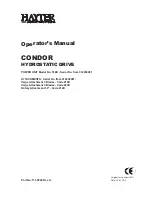
Enabling Channel Output
At the top of each of the channel menu pages is a parameter to enable or dis-
able the channel. Each channel may be individually controlled.
Setting the Channel Timing Parameters
To define a pulse requires two parameters: the delay to the active edge and the
width of the pulse.
Wid:
Sets the channel pulsewidth.
Dly:
Sets the channel delay until the active edge.
Setting Pulse Output Configuration
The 9530 supports two types of outputs: a high speed TTL/CMOS compatible
output and for applications which require different voltage levels or higher cur-
rent, an adjustable voltage output. The pulses can also be defined to be active
high or active low.
Pol:
Sets the pulse polarity, active high or active low.
Out:
Selects the output mode, TTL/CMOS or Adjustable
Ampl:
Sets the output voltage level when in the Adjustable
mode.
Setting Pulse Mode of Operation
Each channel may be set independently to operate in one of four modes: normal,
single shot, burst, or duty cycle (within the CHANNEL menus):
Mode:
Selects the mode for the current channel. Additional
parameters are provided for the burst mode and the
duty cycle mode.
Brst:
Sets the number of pulses in the burst mode to gener-
ate before inhibiting output.
On:
Sets the number of pulses to generate before inhibiting
output in Duty Cycle Mode.
Off:
Sets the number of pulses to inhibit before repeating
the On Cycle in Duty Cycle Mode.
Delaying the Start of Channel Output
Within any channel mode, the output of the channel can be delayed using the
wait parameter (within the CHANNEL menu):
Wait:
Sets the number of T
o
pulses to wait until enabling the
channel output.
Configuring the Channel Multiplexer
To define which channels are fed into the channel multiplexer, the corresponding
bit for the desired channel to add should be set to 1. All desired omitted chan-
nels should have the corresponding bit set to 0.
















































